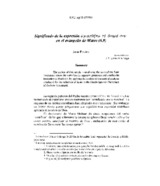Mostrar el registro sencillo del ítem
Significado de la expresión agiasthetó to onoma sou en el evangelio de Mateo (6, 9)
| dc.contributor.author | Peláez del Rosal, Jesús | es_ES |
| dc.date.accessioned | 2010-02-02T09:16:55Z | |
| dc.date.available | 2010-02-02T09:16:55Z | |
| dc.date.issued | 1998 | |
| dc.identifier.issn | 1131-9070 | |
| dc.identifier.uri | http://hdl.handle.net/10396/2634 | |
| dc.description.abstract | The author of this article analysing the texts of the New Testament where the verb ó’yídón appears, proposes and justifies its translation in Matth 6:9. by applying the method of semantical analysis employed for te redaction of items in the Greek-Spanish Dictionarv of the New Testament | en |
| dc.format.mimetype | application/pdf | es_ES |
| dc.language.iso | spa | es_ES |
| dc.publisher | Universidad Complutense, Servicio de Publicaciones | es_ES |
| dc.rights | https://creativecommons.org/licenses/by-nc-nd/4.0/ | es_ES |
| dc.source | Cuadernos de Filología Clásica. Estudios griegos e indoeuropeos (8), 43-52 (1998) | es_ES |
| dc.subject | Hermenéutica | es_ES |
| dc.subject | Evangelio de Mateo | es_ES |
| dc.subject | Nuevo Testamento | es_ES |
| dc.title | Significado de la expresión agiasthetó to onoma sou en el evangelio de Mateo (6, 9) | es_ES |
| dc.type | info:eu-repo/semantics/article | es_ES |
| dc.relation.publisherversion | http://revistas.ucm.es/fll/11319070/articulos/CFCG9898110043A.PDF | |
| dc.rights.accessRights | info:eu-repo/semantics/openAccess |

